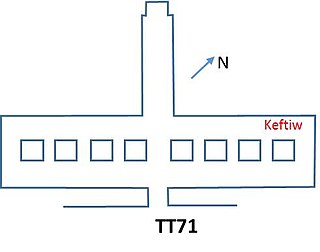
Theban Tomb TT71 is located in the Theban Necropolis, on the west bank of the Nile, opposite to Luxor. It was the tomb chapel of Senenmut, who was the steward and architect of Hatshepsut. The chapel is located in the necropolis area around Sheikh Abd el-Qurna. Previously the tomb was accessible and for most of this time the target of numerous investigations and intrusions, although early on already heavily destroyed. The tomb was visited already early. In the first half of the nineteenth century, John Gardner Wilkinson, Robert Hay and J. Wild copied scenes, although the decoration was already badly destroyed. Richard Lepsius (1842–45) took the false door to Berlin and copied some inscribed bricks. Only in 1906 Kurt Sethe copied all inscriptions. In 1930–31 Herbert Winlock cleared the whole tomb. Winlock found the fragments of a smashed sarcophagus.
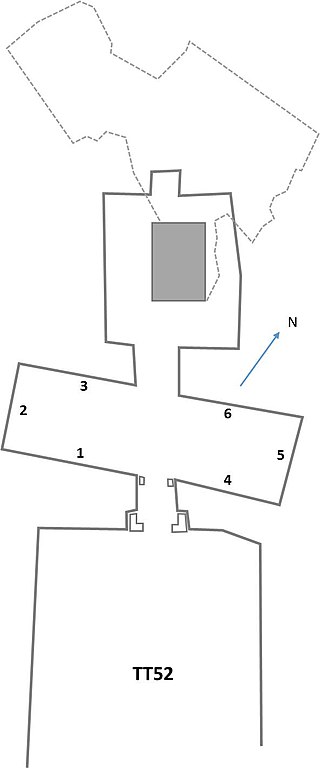
The Theban Tomb TT52 is located in Sheikh Abd el-Qurna, part of the Theban Necropolis, on the west bank of the Nile, opposite to Luxor. It is the burial place of Nakht, an ancient Egyptian official who held the position of a scribe and astronomer of Amun, probably during the reign of Thutmose IV during the Eighteenth Dynasty, the first dynasty of the New Kingdom.

Theban Tomb 69 is located in Sheikh Abd el-Qurna, part of the Theban Necropolis, on the west bank of the Nile, opposite Luxor. It is the burial place of the ancient Egyptian official named Menna, whose titles included ‘Overseer of Fields of Amun’, and ‘Overseer of Fields of the Lord of the Two Lands’. Traditionally, TT 69 has been dated to the reign of Thutmosis IV. However, recent art historical studies of artistic style suggest the majority of the tomb was decorated during the reign of Amenhotep III.

The Theban Tomb TT100 is located in Sheikh Abd el-Qurna, part of the Theban Necropolis, on the west bank of the Nile, opposite to Luxor. It is the mortuary chapel of the ancient Egyptian vizier Rekhmire. There is no burial chamber next to this chapel. The vizier's tomb is elsewhere, perhaps even in the Valley of the Kings.

Tomb TT192, located in the necropolis of El-Assasif in Thebes, Egypt, is the tomb of Kheruef, also called Senaa, who was Steward to the Great Royal Wife Tiye, during the reign of Amenhotep III. It is located in El-Assasif, part of the Theban Necropolis.
The Theban Tomb TT36 is located in El-Assasif, part of the Theban Necropolis, on the west bank of the Nile, opposite to Luxor. It is the burial place of the ancient Egyptian Ibi, who was "Chief Steward of the Adorer of the God", during the reign of Psamtik I during the 26th dynasty.

The Theban Tomb TT37 is located in El-Assasif. It forms part of the Theban Necropolis, situated on the west bank of the Nile opposite Luxor. The tomb is the burial place of the ancient Egyptian Harwa, who was Chief Steward of the God's Wife of Amun, Amenirdis I, during the 25th Dynasty. Harwa was the son of the scribe Pedemut and his wife Estawert.
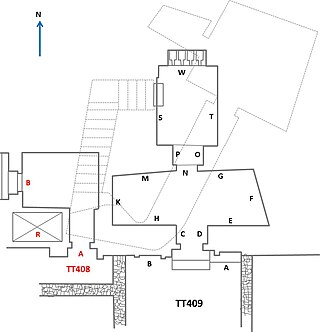
The Theban Tomb TT409 is located in El-Assasif, part of the Theban Necropolis, on the west bank of the Nile, opposite to Luxor. It is the burial place of the ancient Egyptian Samut called Kyky, who was Accountant of Cattle of the Amun domain, during the reign of Ramesses II during the Nineteenth Dynasty.
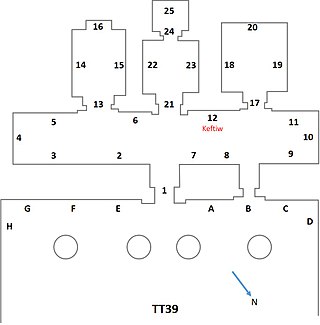
The Theban Tomb TT39 is located in El-Khokha, part of the Theban Necropolis, on the west bank of the Nile, opposite to Luxor. It is the burial place of the ancient Egyptian official, Puimre.

The Theban Tomb TT57 is located in Sheikh Abd el-Qurna. It forms part of the Theban Necropolis, situated on the west bank of the Nile opposite Luxor. The tomb is the burial place of the ancient Egyptian official Khaemhat, who was royal scribe and overseer of double granary, during the reign Amenhotep III. The relief decoration of the tomb is regarded as the best of New Kingdom art.

The Theban Tomb TT18 is located in Dra' Abu el-Naga', part of the Theban Necropolis, on the west bank of the Nile, opposite to Luxor. It is the burial place of the ancient Egyptian Baki, who was Chief Weigher of the Gold of Amun during the early Eighteenth Dynasty.
The Theban Tomb TT47 is located in El-Khokha, part of the Theban Necropolis, on the west bank of the Nile, opposite to Luxor.
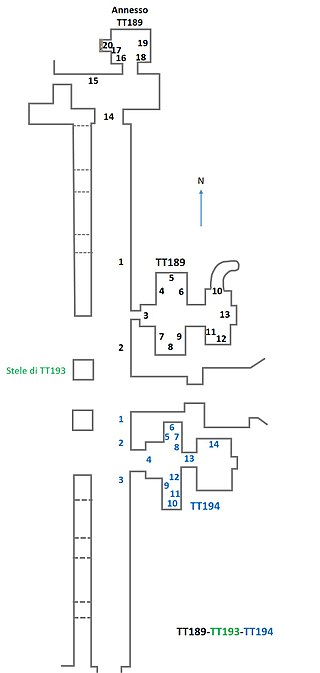
Tomb TT189 is located in the necropolis of El-Assasif in Thebes, Egypt. It contains the sepulchre of Nakhtdjehuty, who was an overseer of the carpenters of the northern lake of the god Amun and the head of the goldworkers in the Estate of Amun during the 19th Dynasty reign of Ramesses II. Nakhtdjehuty's tomb is part of the TT192 tomb complex.

The Theban Tomb TT82 is located in Sheikh Abd el-Qurna, part of the Theban Necropolis, on the west bank of the Nile, opposite to Luxor. It is the burial place of the ancient Egyptian official Amenemhat, who was a counter of the grain of Amun and the steward of the vizier Useramen. Amenemhat dates to the Eighteenth Dynasty of Egypt, from the time of Tuthmosis III. As the scribe to the vizier Useramen Amenemhat documents the work in Thebes up to ca year 28. This includes the withdrawal of silver, precious stines and more form the treasury and the manufacture of a number of statues made from silver, bronze and ebony. He also mentions the creation of a large lake near Thebes surrounded by trees and work on the royal tomb.
Iunmin was a vizier from the Fourth Dynasty of Egypt. He was possibly a son of king Khafre. He served as vizier towards the end of the dynasty, possibly during the reign of his brother Menkaure.

Tomb TT374, located in the necropolis of El-Khokha in Thebes, Egypt, is the tomb of the Scribe of the Treasury of the Ramesseum, Amenemope.
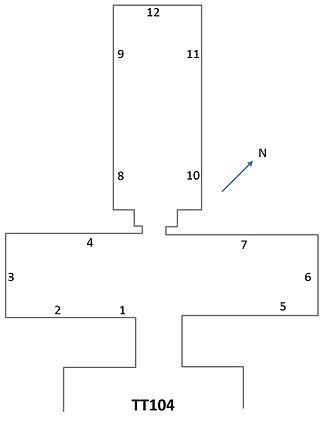
The ancient Egyptian Theban Tomb no. 104 (TT104) belongs to the Overseer of the treasuries Djehutynefer, who was in office under king Amenhotep II. The tomb chapel is located in Sheikh Abd el-Qurna and is part of the Theban Necropolis, on the west bank of the Nile, opposite to Luxor. Djehutynefer had a second tomb in Thebes TT80. Tomb TT104 is decorated with paintings and has a T-shaped ground plan. The paintings are not always well preserved.

Tomb TT406, located in the necropolis of El-Assasif in Thebes, Egypt, is the tomb of Piay, a scribe of the offering table of the Lord of the Two Lands dated to the Ramesside period. It is located in El-Assasif, part of the Theban Necropolis.
Theban Tomb TT72 is located in the Theban Necropolis, on the west bank of the Nile, opposite to Luxor. It was the tomb of Re, who was the First Prophet of Amun in the Mortuary temple of Thutmosis III. The tomb is located in the necropolis area around Sheikh Abd el-Qurna and dates to the time of Amenhotep II.
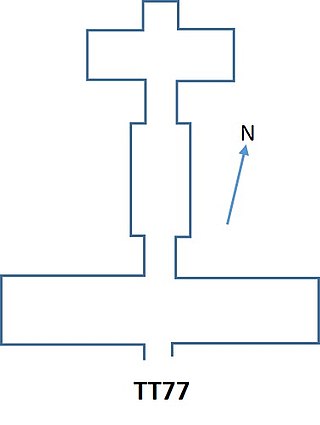
Theban Tomb 77 is located in Sheikh Abd el-Qurna, part of the Theban Necropolis, on the west bank of the Nile, opposite Luxor. It is the burial place of the Ancient Egyptian official named Ptahemhat, who was a child of the nursery, overseer of the works in the temple of Amun, and standard-bearer of the Lord of the Two Lands. The tomb dates to the reign of Tuthmosis IV.
















